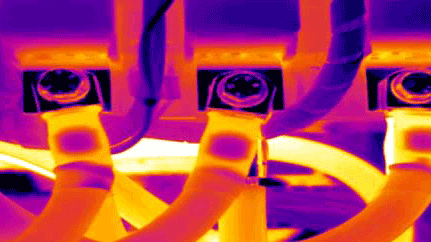Infrared Thermography
Infrared thermography is the process of acquisition and analysis of thermal information from non-contact thermal imaging devices. Stated another way: Infrared thermography is equipment or method, which detects infrared energy emitted from an object, converts it to temperature, and displays an image of temperature distribution. (writing with heat)
Characteristics of Infrared Thermography Equipment
Non-Contact
- Potentially keeps the user out of danger
- Doesn’t intrude upon or affect the target
Two-dimensional
- Compares areas of the target
- Excellent overview of the target
- Thermal patterns easily targeted
Real time
- Very fast scanning of stationary targets
- Capture fast moving targets
- Capture of fast-changing targets
Benefits of Infrared Thermography
- Significantly reduce unscheduled power outages by finding potential problems early
- Detect problems quickly, without interrupting service
- Assist with corrective action
- Minimize preventive maintenance and troubleshooting time
- Comply with insurance company requirements
- Check for defective equipment while still under manufacturer warranty
Electrical Systems
- Substations and transmission lines
- Switchgear, panelboards, fuses, circuit breakers, transformers, and capacitor banks
- Starters, VFDs, disconnects, motor control centers and motors
- Low voltage systems: PLCs, relays, terminal strips, and DIN rails
- Generators, UPS, and battery systems
Building Envelopes & Structures
- Thermal heat loss inspections for buildings, plants, facilities, and refineries
- Moisture contamination evaluations in commercial and residential buildings, plants, and facilities
- Concrete in floor heat inspections for leaks and temperature distribution
- Location of missing or damaged insulation
- Identification of air leakage energy losses
- Evaluation of the thermal performance of retrofits
- Location of radiant heating wires or pipes
- Verification of thermal breaks in construction
Roofing Systems
- Detect flat roof leaks for buildings, plants, and facilities
- Identify water-damaged portions of a roof quickly and accurately
- Eliminate unnecessary replacement of good roofing
- Document problems before the warranty/bond expires
Mechanical Systems
- Detect duct/piping blockages and leaks
- Detect buildup in duct/piping systems
- Detect issues with valves, traps, etc.
- Detect thermal patterns on boiler tubes, heat exchangers, chillers, etc.
- Detect flue gas leaks
- Evaluate heating, ventilation, and air conditioning equipment
- Find cold storage cooling losses
- Detect insulation leaks in refrigeration equipment
- Tanks and vessel level analysis
- Analyze motors, gears, bearings, belts etc.

